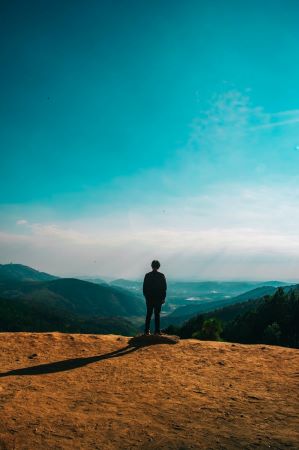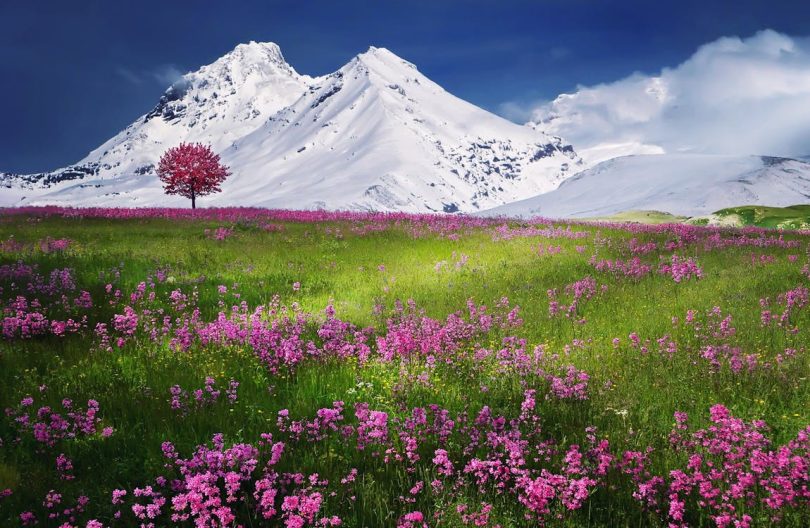Imagine standing in a glade of wildflowers.
You gaze at the lazily burbling mountain stream.
The sun caresses your face.
You see the clouds slowly puffing across the blue blue sky.
Looking up, you see dragons, sheep and hippos, all of the imaginal things…
A cool refreshing breeze flows across the valley and your skin.
The peace, and the smells and sounds of nature allow you to take a full breath.
You are still.
You breathe.

Notice how you feel.
Imagine what it might be like to invite more of that feeling, sensation into your life.
Paraeidolia is the psychological phenomenon where we see shapes in clouds, pictures of the cosmos, rock formations and other natural occurrences. We might also call it the art of daydreaming, a pathway into the creative imagination…a journey into the liminal space of the unconscious.

What is Yoga Nidra?
Betwixt and between our waking and dreaming selves, is the place where we experience yoga nidra – awakened yogic sleep. The ancient yogis believed that yoga nidra was another path to samadhi, enlightenment, the path of turiya (the fourth), or chaturtha. Some of the same qualities we experience whilst daydreaming, are the qualities present in yoga nidra.
Yoga nidra is a form of system guided meditative relaxation that is performed lying down, in savasana, the corpse pose.
The practice usually includes some form of body scan, or muscle tensing to support the guided practice.
More advanced practices may include visualisations or perceiving the screen of the mind. For longer practices, it can be helpful to use bolsters, cushions, blocks and blankets for a more comfortable experience. A practice can be between five minutes and over an hour.

As we surrender to the guided practice, connecting breath with the body scan, there is an effortlessness and sense of waking/dreaming that may emerge, invoking deep rest and relaxation.
Some yoga nidra practices include the setting of a sankalpa, an intention, to seed that creative force into our unconscious waking/dreaming state.
What happens if I fall asleep?
Some like to prop themselves at an angle or rest their elbow on the ground to stop drifting off. Personally, I believe that if you’re tired, you’re tired and it is valuable to surrender to rest, and sleep. The practice is deeply restorative. Your body will let you know what it needs. When you feel fully rested, your engagement with yoga nidra shifts, and a deeper experience begins to emerge.
What are the benefits of Yoga Nidra?
On a physical level, Yoga Nidra helps with stress and pain management, promoting relaxation.
This deeper experience of rest and relaxation aligning breath awareness with flowing awareness through the body supports a calming of the nervous system, inviting the waking/dreaming meditative state.

Yoga Nidra allows us to explore the space of our body, and the space it resides in, in a gentle and flowing way, that allows us to touch on the painful parts of our experience held in our bodies. This may be experienced as a knot, an area of discomfort or pain, and perhaps an area with a strong visual. Over time, as we become more resourced, the invitation is to dive deeper into awareness of the knots of experience or pain held in our physical and energetic bodies.
At a time when I was struggling with neuropathic pain, yoga nidra was my practice. I believe that not only did it help with my stress and pain, it also helped with healing.
How does Yoga Nidra compare to NSDR?
You may have come across a modernised form of Yoga Nidra already. Non-Sleep Deep Rest (NSDR) is a form of mindful breathing and body scanning based on yoga nidra principles. It claims to support enhanced learning and memory, focus, better sleep and creativity.

So how do I begin?
Simply lie down somewhere comfortable with your hands by your side and soften your gaze or close your eyes. Just before you sleep in bed works, although you might not want to use a pillow to keep the neck relaxed, and try this:
- Inhale and exhale through your nostrils until both are even
- Bring your awareness to your head, and on an exhale, scrunch up all of the muscles of your face. Take a breath, and then release on your next inhale.
- Bring your awareness to your neck and shoulders, and repeat
- Bring your awareness to your arms, making fists, and repeat
- Bring your awareness to your torso and repeat
- Bring your awareness to your lower body and lets, and scrunch up your feet and repeat
- Bring your awareness to your whole body and scunch up all your muscles on your next exhale and breathe, holding the tension for as long as you can. Release on the next comfortable inhale
- Release everything and just notice the breath at the tip of your nose as you inhale and exhale
- Rest in awareness for as long as feels comfortable
- Roll over to one side, take 3 breaths, and your practice is complete.

I wish you joy of practice.
May you find peace & rest in your body.
Main – Photo by Pixabay



